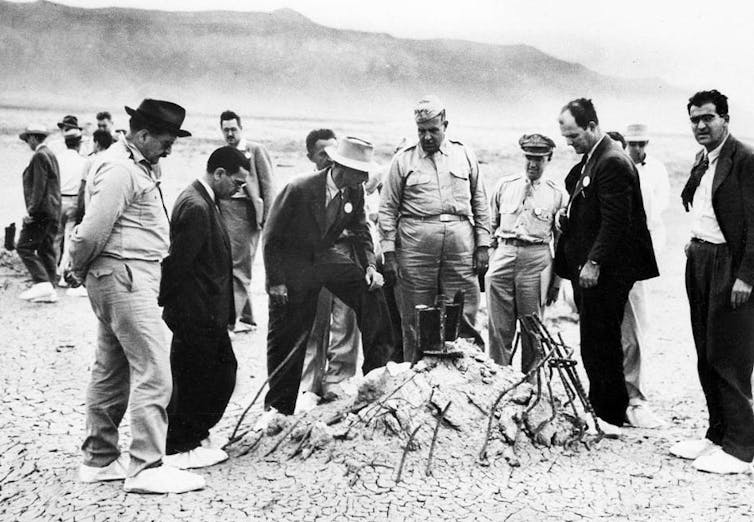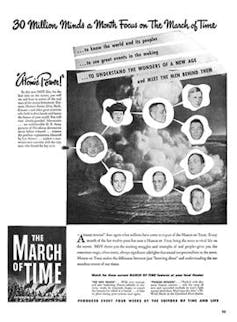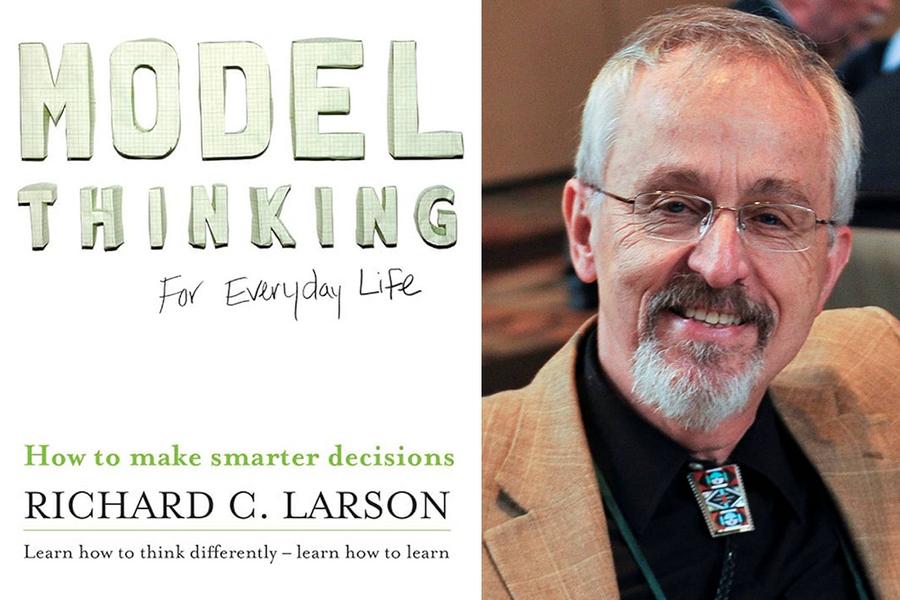
US Army Signal Corps
Timothy Noël Peacock, University of Glasgow
Atomic Power, a groundbreaking 18-minute black-and-white film about the Manhattan Project which created the world’s first atomic bomb, may not be as famous as Christopher Nolan’s 2023 epic, Oppenheimer. However, this largely overlooked 1946 cinematic experience was pioneering in communicating the history behind the nuclear detonation in the New Mexico desert on July 16 1945.
Particularly striking in Atomic Power is that leading figures play themselves, including Robert Oppenheimer, Leslie Groves and even Albert Einstein. This film, which offers a unique window on the dawn of the Atomic Age, resonates with its 2023 counterpart.
Atomic Power was released when only 44,000 US households had television, so millions saw it in cinemas. It was part of a major American newsreel series, The March of Time (1935-1951), created by Time magazine’s co-founder Henry Luce and produced by Louis de Rochemont.
These films were “a unique combination of newsreel and documentary formats”. They involved dramatised recreations and commentary on significant current events, and are regarded as having a profound impact on contemporary filmmaking. Even the narration by Cornelius Westbrook Van Voorhis – whose “voice epitomised 20th-century announcer speak” – was genre-defining.
However, telling this story comes with many problems. Both films struggle to juggle depicting genius and technological advance with the reality of nuclear power.
Nuclear messages on film
The message of 2023’s Oppenheimer blockbuster has been variously interpreted. Some critics have focused on how the atomic bomb represents a fundamental change in global technology its portrayal of Oppenheimer and other figures grappling with the moral dilemmas around this.
Other critics, however, have suggested the film “skirts around the human suffering caused by the bomb”. Oppenheimer’s grandson Charles summarised the film’s central question as: “Are we going to destroy ourselves as a species?” But in the same Time interview, he added that “the movie, while really good, had less emphasis than I would have put” on the crucial period of 1945 to 1947, during which Atomic Power was made.
That film’s poignant release date, August 9 1946, was exactly a year after the atomic bombing of Nagasaki in Japan. In contrast to 2023, the world did not yet have nuclear-armed rockets, nuclear-powered submarines, nor even commercial nuclear power stations.
At that time, the US was the only country with nuclear weapons – only 11 bombs in 1946, deliverable by propeller-driven B-29 bombers. And there were even US proposals being discussed at the UN for the (unsuccessful) Baruch Plan. Named after Bernard Baruch, the US representative to the UN’s Atomic Energy Commission, this plan sought to dismantle all US nuclear weapons and place atomic technology under international control.
The plan failed largely on account of the Soviet Union’s abstention and pursuit of a counter proposal. Russia believed the UN to be insufficiently independent, and
that the plan would simply protect the US’s atomic monopoly.
These negotiations were not helped by the US’s Operation Crossroads nuclear tests in the Pacific during July 1946, nor by the Soviet Union engaging in its own secret atomic bomb programme.
Atomic Power’s message is similarly complicated. Having initially echoed concerns about the new technology, it ends up hoping for peace and responsible use while featuring news footage and a reference to the ill-fated Baruch Plan.
But the film largely focuses on communicating the technological triumph of creating an atomic bomb. It opens with images of buildings in a devastated Hiroshima, then cuts to a staged grocery store conversation with an unnamed American woman who is lamenting the loss of life. A similarly anonymous pastor offers a one-sentence morality injection:
It’s overstepped the bounds of moral law by producing this diabolical weapon.
While featuring such perspectives appears thought-provoking, these are in fact brushed aside almost immediately, replaced with scientific explanations and the project’s story. Potential dangers are revisited later, but purely through the hypothetical threats to US cities.
Surreal moments

Wikimedia
Oppenheimer is noted for its sometimes surreal and “artful” depictions. Atomic Power’s dramatisation, though seemingly more conventional, offers equally surreal takes.
Most striking is a scene involving Vannevar Bush and James B. Conant, who both played significant government oversight roles in the Manhattan Project. Real nuclear detonation footage is interspersed with the two “witnessing” the blast by lying on the desert sand – facing away, shielding their eyes when turning round, then casually shaking hands. There’s not even a breath of wind to ruffle their hair.
This unbelievably detached re-enactment was filmed in a Boston garage – and the scene reflects wider disparities between the reality and the cinematic recreation. Conant’s own account, written the day after the real event, conveyed a great sense of fear when facing the bomb.
Oddly, Atomic Power barely features Oppenheimer, who is reduced to a single scene with two lines. In a desert control room, just before detonation, he speaks with his close friend and Manhattan Project consultant, Isidor Isaac Rabi:
Oppenheimer: “The automatic control’s got it now. Rabi, this time the stakes are really high.”
Rabi: “It’s going to work alright Robert, and I’m sure we’ll never be sorry for it.”
Oppenheimer: “Well, in 40 seconds we’ll know.”
This subconscious hinting at Oppenheimer’s inner doubts, and of his being at the mercy of a mechanical process, foreshadow his later public challenging of US nuclear policy and being sidelined through “political machinations” – both powerful themes that are central to the 2023 biopic.
In contrast to Oppenheimer, Einstein is given greater accolades in Atomic Power – reified for his “genius” discoveries and letter to US president Franklin D. Roosevelt that made nuclear weapons possible. Yet his only words near the film’s end are “I agree,” which he says in response to a statement by the Emergency Committee of Atomic Scientists (of which Einstein was Chairman) appealing for support for funding to educate the public.
Even military figures have surprisingly limited profiles in the film. Groves’s only line, having led the project, is cautioning an unnamed scientist to be careful with a $50m plutonium test-tube. Ironically, this portrayal hints at the very real military-scientific tensions during and after the project.
Atomic Power’s final words are the catchphrase that the series was by then well-known for: “Time … marches on!” Indeed it did, yet we continue to be drawn to this complex and murky story and what it tells us about humanity. I’m sure Oppenheimer won’t be the last time filmmakers attempt to tell it.
Atomic Power can be watched for free through the BFI player

Looking for something good? Cut through the noise with a carefully curated selection of the latest releases, live events and exhibitions, straight to your inbox every fortnight, on Fridays. Launches 4 August. Sign up here.![]()
Timothy Noël Peacock, Lecturer in History, University of Glasgow
This article is republished from The Conversation under a Creative Commons license. Read the original article.









